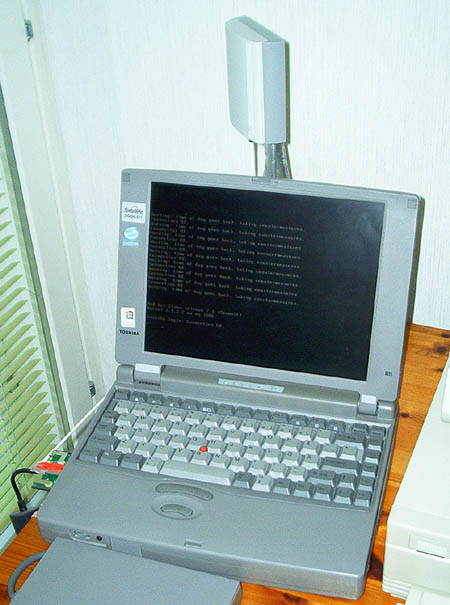TOSHIBA Satellite 200CDT laptop |

| HOSTNAME | TOSHIBA |
| SYSTEM CPU | Intel Pentium @100MHz |
| CACHE (2nd, 1st D/I) | 0 KB, 8 KB / 8 KB |
| RAM | 40 MB EDO DRAM (Max. 40 MB) |
| IDE BUS | 1 x EIDE (Max. 16.6 MB/s) |
| OPTION BUS | 2 x PCMCIA Card Slots |
| GRAPHICS | Chips & Tech. 24-plane 800 x 600 @60Hz |
| DISPLAY |
11.3" TFT 800 x 600 |
| HARD DISK DRIVE | 6.4GB IBM 5400 RPM |
| CD-ROM DRIVE | 6x Toshiba EIDE, in the drive bay |
| FLOPPY
DRIVE |
1.44MB Floppy drive, in an
external box |
| NETWORK | 10baseT or 10base2 PCMCIA card, Lucent Orinoco WLAN 11Mbps + external 2.5 dBi planar antenna (visible in the picture above) |
| AUDIO | Onboard ESS688 & OPL3 audio chips |
| OS | RedHat Linux V7.1 |
| YEAR | 1996 |
| SPEED | 84 VAX MIPS |
| COMMENTS | Linux runs OK on this machine. Unfortunately it's a bit too slow for X11 + KDE for example. |
| ESTIAMATED
PRICE '96 |
$6,000 |
Linux version 2.4.2-2 (gcc version 2.96 20000731 (Red Hat Linux 7.1 2.96-79)) #1 Sun Apr 8 19:37:14 EDT 2001 BIOS-provided physical RAM map: BIOS-88: 000000000009f000 @ 0000000000000000 (usable) BIOS-88: 0000000002730000 @ 0000000000100000 (usable) On node 0 totalpages: 10288 zone(0): 4096 pages. zone DMA has max 32 cached pages. zone(1): 6192 pages. zone Normal has max 48 cached pages. zone(2): 0 pages. zone HighMem has max 1 cached pages. Kernel command line: auto BOOT_IMAGE=linux ro root=307 BOOT_FILE=/boot/vmlinuz-2.4.2-2 Initializing CPU#0 Detected 99.954 MHz processor. Console: colour VGA+ 80x25 Calibrating delay loop... 199.06 BogoMIPS Memory: 38076k/41152k available (1363k kernel code, 2688k reserved, 92k data, 232k init, 0k highmem) Dentry-cache hash table entries: 8192 (order: 4, 65536 bytes) Buffer-cache hash table entries: 1024 (order: 0, 4096 bytes) Page-cache hash table entries: 16384 (order: 5, 131072 bytes) Inode-cache hash table entries: 4096 (order: 3, 32768 bytes) VFS: Diskquotas version dquot_6.5.0 initialized CPU: Before vendor init, caps: 000001bf 00000000 00000000, vendor = 0 Intel Pentium with F0 0F bug - workaround enabled. CPU: After vendor init, caps: 000001bf 00000000 00000000 00000000 CPU: After generic, caps: 000001bf 00000000 00000000 00000000 CPU: Common caps: 000001bf 00000000 00000000 00000000 CPU: Intel Pentium 75 - 200 stepping 0c Checking 'hlt' instruction... OK. POSIX conformance testing by UNIFIX mtrr: v1.37 (20001109) Richard Gooch mtrr: detected mtrr type: none PCI: No PCI bus detected isapnp: Scanning for PnP cards... isapnp: No Plug & Play device found Linux NET4.0 for Linux 2.4 Based upon Swansea University Computer Society NET3.039 Initializing RT netlink socket apm: BIOS version 1.2 Flags 0x02 (Driver version 1.14) Starting kswapd v1.8 pty: 256 Unix98 ptys configured block: queued sectors max/low 25138kB/8379kB, 128 slots per queue RAMDISK driver initialized: 16 RAM disks of 4096K size 1024 blocksize Uniform Multi-Platform E-IDE driver Revision: 6.31 ide: Assuming 50MHz system bus speed for PIO modes; override with idebus=xx hda: IBM-DADA-26480, ATA DISK drive hdc: TOSHIBA CD-ROM XM-1402B, ATAPI CD/DVD-ROM drive ide0 at 0x1f0-0x1f7,0x3f6 on irq 14 ide1 at 0x170-0x177,0x376 on irq 15 hda: 12685680 sectors (6495 MB) w/460KiB Cache, CHS=789/255/63 Partition check: hda: hda1 hda2 < hda5 hda6 hda7 > hda3 Floppy drive(s): fd0 is 1.44M FDC 0 is an 8272A Serial driver version 5.02 (2000-08-09) with MANY_PORTS MULTIPORT SHARE_IRQ SERIAL_PCI ISAPNP enabled ttyS00 at 0x03f8 (irq = 4) is a 16550A ttyS01 at 0x02f8 (irq = 3) is a 16550A Real Time Clock Driver v1.10d md driver 0.90.0 MAX_MD_DEVS=256, MD_SB_DISKS=27 md.c: sizeof(mdp_super_t) = 4096 autodetecting RAID arrays autorun ... ... autorun DONE. NET4: Linux TCP/IP 1.0 for NET4.0 IP Protocols: ICMP, UDP, TCP, IGMP IP: routing cache hash table of 512 buckets, 4Kbytes TCP: Hash tables configured (established 4096 bind 4096) Linux IP multicast router 0.06 plus PIM-SM NET4: Unix domain sockets 1.0/SMP for Linux NET4.0. VFS: Mounted root (ext2 filesystem) readonly. Freeing unused kernel memory: 232k freed Adding Swap: 136544k swap-space (priority -1) Linux PCMCIA Card Services 3.1.22 options: [pci] [cardbus] [pm] Intel PCIC probe: Intel i82365sl B step ISA-to-PCMCIA at port 0x3e0 ofs 0x00, 2 sockets host opts [0]: none host opts [1]: none ISA irqs (scanned) = 3,4,5,9,10,11,12 status change on irq 11 cs: IO port probe 0x0c00-0x0cff: excluding 0xc00-0xc7f 0xca0-0xcc7 0xcd0-0xcef cs: IO port probe 0x0100-0x04ff: excluding 0x1f8-0x1ff 0x220-0x22f 0x378-0x37f 0x388-0x38f 0x400-0x4c7 0x4d0-0x4ef cs: IO port probe 0x0a00-0x0aff: excluding 0xa20-0xa2f cs: memory probe 0x0d0000-0x0dffff: clean. eth0: NE2000 Compatible: io 0x300, irq 3, hw_addr 00:00:00:00:00:00 NET4: Linux IPX 0.46 for NET4.0 IPX Portions Copyright (c) 1995 Caldera, Inc. IPX Portions Copyright (c) 2000, 2001 Conectiva, Inc. wvlan_cs: WaveLAN/IEEE PCMCIA driver v1.0.6 wvlan_cs: (c) Andreas Neuhaus wvlan_cs: index 0x01: Vcc 5.0, irq 5, io 0x0100-0x013f wvlan_cs: Registered netdevice eth1 wvlan_cs: MAC address on eth1 is 00 02 2d 2b ae 0e NET4: AppleTalk 0.18a for Linux NET4.0 ip_tables: (c)2000 Netfilter core team ip_conntrack (321 buckets, 2568 max) wvlan_cs: MAC address on eth1 is 00 02 2d 2b ae 0e NET4: Linux IPX 0.46 for NET4.0 IPX Portions Copyright (c) 1995 Caldera, Inc. IPX Portions Copyright (c) 2000, 2001 Conectiva, Inc. NET4: AppleTalk 0.18a for Linux NET4.0 |
| Last updated: | 15-7-2004 |